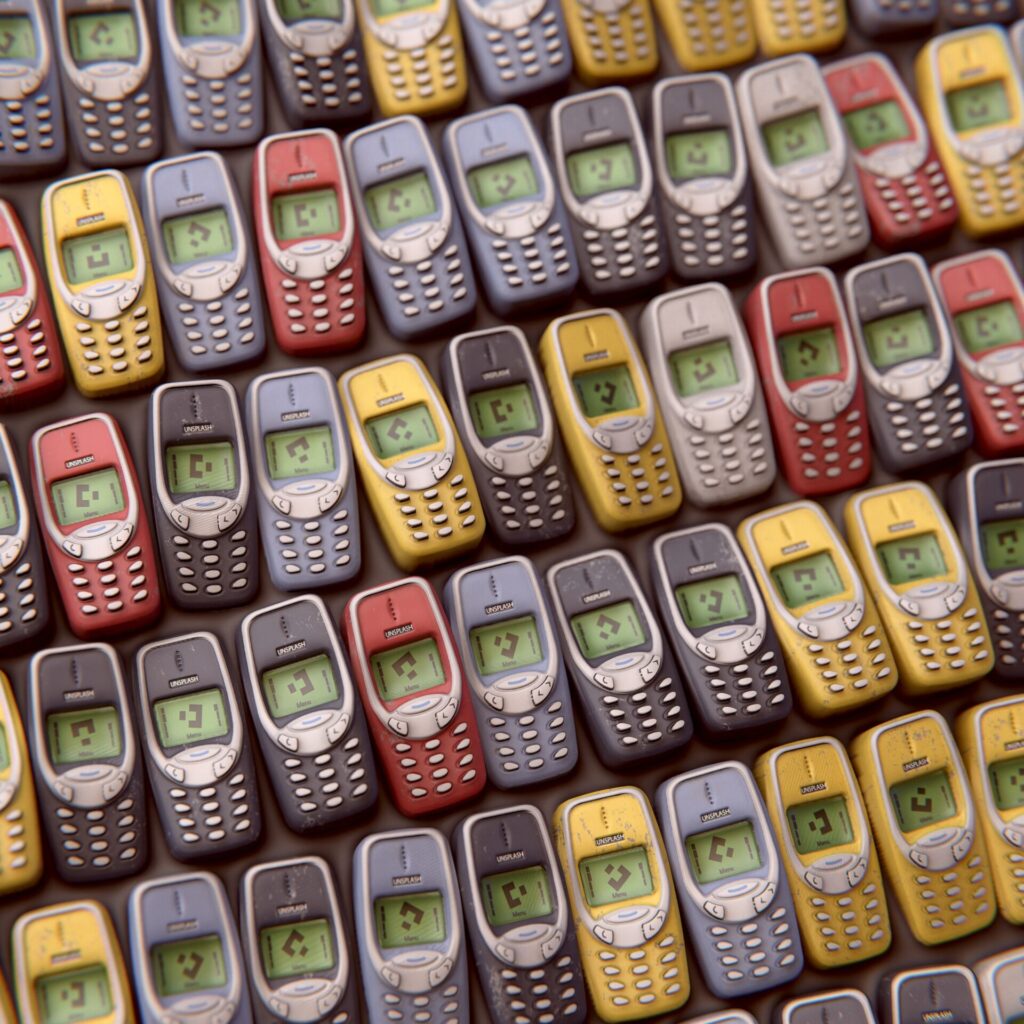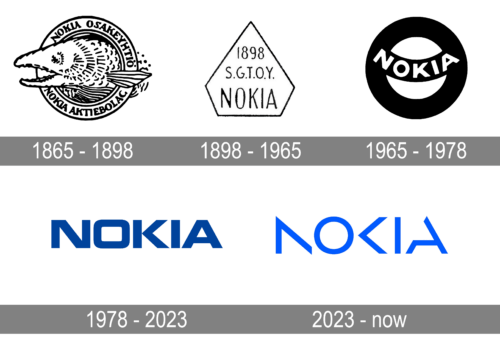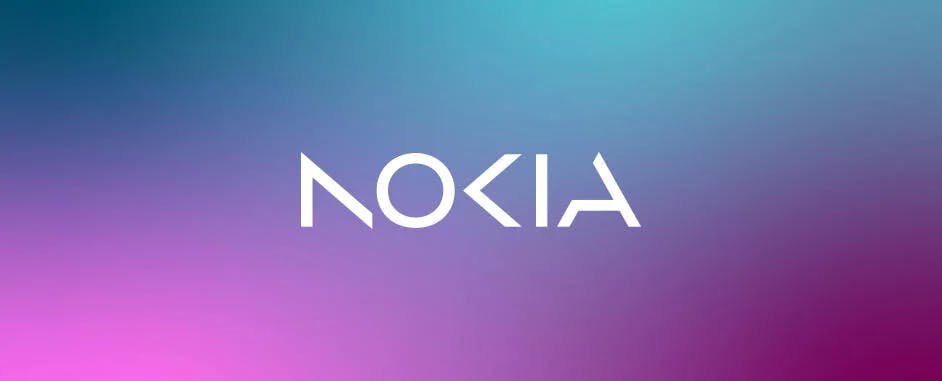
Nokia, once the undisputed king of the mobile phone market, has struggled to maintain its position in recent years. The Finnish company’s fortunes began to decline with the emergence of Apple’s iPhone and the Google Android operating system, which quickly gained a foothold in the mobile market. Today, it’s rebranding into something totally different.
The company has been around for over 150 years, and in those years, it has changed its logo about five times. Nokia’s first logo was created in 1866, an image of a fish. Founded in 1865, it wasn’t always a telecommunications company; it started out as a forestry endeavor. Over the years, Nokia has diversified into various industries, including rubber, cable, electronics, and telecommunications. However, it wasn’t until the 1990s that the brand became a household name with its mobile phones.
In this discourse, we will look at Nokia’s ascent to fame, its hegemony in the mobile phone market, its eventual decline, and how it is currently pivoting its brand image.

Nokia’s Early Years
Nokia’s early years were focused on the pulp and paper industry, but as of the 1980s, the company had already begun to explore the telecommunications industry, which would eventually become its primary focus. The company made significant contributions to history and accomplished many feats during its ascent.
In the history of the mobile phone business, Nokia was among the pioneering companies. it introduced the Nordic Mobile Telephone Network, the first global cellular system that connected the four Nordic nations of Sweden, Denmark, Norway, and Finland.
Though mobile phones were originally incorporated into the company’s product lineup in the 1980s, it had already been engaged in communications since the 1960s. In 1987, Nokia launched the world’s first handheld NMT (Nordic Mobile Telephone) device, the Mobira Cityman. The device was a large, brick-shaped device that weighed about 2 pounds and cost over $4,000. Although expensive, it was considered an upscale instrument and a status symbol and was mostly sold to affluent metropolitan professionals.
The Mobira Cityman, which is known as the world’s first lithium-ion phone, gained notoriety and earned the moniker “The Gorba,” after Mikhail Gorbachev, the president of the Soviet Union at the time, used it to call Moscow from Helsinki during a press conference in 1987. A few years prior, Nokia introduced the first car phone—the Mobira Senator—released in 1982, and in 1984, it launched what is known as the first portable automobile phone in history, the Mobira Talkman.
Rise to Prominence with Mobile
Nokia’s ascent to fame can be attributed to its decision to concentrate on mobile phones in the early 1990s. The Guardian reported that in 1998, Nokia rose to the top of the global mobile phone market. From 1996 to 2001, Nokia’s revenue increased from €6.5 billion to €31 billion, nearly five times. The company’s staff expanded by 150% to 27,353 during the same period. As of 1999, it was already the world’s biggest mobile phone maker.
The company claimed that Harri Holkeri, the prime minister of Finland, used a Nokia device to place the first “global system for mobile communications” call in history. The call, which lasted just over three minutes, was between him and Deputy Mayor of Tampere Kaarina Suonio on July 1, 1991.
The 2100 series, launched in 1994, was the first phone to feature the Nokia Tune ringtone, and despite Nokia’s aim being 400,000 phones, the series went on to sell 20 million phones globally. Nokia released the 7110 series, a phone with basic web-based features, including email, five years later.
Colloquially dubbed the “Matrix phone,” the 7110 model connects to the internet using Wireless Application Protocol (WAP) and the Orange network. It was described as “the precursor to all phones up until the advent of touchscreen technology.” by Microsoft. In the same year, Nokia briefly became the most valuable company in Europe.
Remember the snake game? The first mobile device to ship with the game pre-installed was the Nokia 6110. After the series’s 1998 release, the business surpassed Motorola to take the top ranking among cellular phone manufacturers in the globe. The company sold nearly 41 million cellular phones in the same year.
After introducing its first phone with a built-in camera, the Nokia 7650, in the year 2001. The Nokia 3650, which was the company’s first video capture phone, and the Nokia 6650, its first 3G phone, were both released in 2002. The capabilities offered by the second generation were improved by 3G technology, which provided more sophisticated functions. It made it feasible to use a mobile phone to do things like browse the web, download music, and watch TV on the go, in addition to many more functions.
Decline and Revival
In 2004, Nokia issued a warning that, despite dominating the market, it was losing ground to rivals because its new line of devices was lagging behind. In contrast to its aim of 40%, the company’s market share was 35%. Three years earlier, it also issued a profit warning, attributing it to a downturn in the mobile industry, and announced intentions to lay off 1,000 employees. Nevertheless, towards the end of the year, things start to improve. According to data from the research firm Gartner, Nokia’s market share reached a peak of about 50% in 2007.
But things were about to take a sharp turn. In January 2007, Steve Jobs introduced a device that will change the world forever, the iPhone. The same year, just a few months after the iPhone was made available in the United States, Nokia, was forced to issue what was then referred to as one of the biggest product recalls ever after admitting that 46 million of its phones may have defective batteries. Reports have it that the disclosure caused the company’s stock price to drop by more than half a billion pounds. Analysts did estimate that the recall may cost as much as €500 million (£340 million).
In the following years, Nokia’s market share decreased rapidly. As of 2008, Nokia reported a 30% fall in third-quarter profits. In contrast to an increase of 327.5% in Apple iPhone sales, Nokia smartphone sales decreased by 3.1% during the quarter. The following year, as the recession affects sales of mobile phones, Nokia announces intentions to reduce 1,700 employees globally.
A Wall Street Journal article reported that Nokia engineers said that they thoroughly investigated the iPhone when it first came out and found that it did not pose an imminent danger. Olli-Pekka Kallasvuo, the CEO of Nokia at the time, stated that there was nothing to be concerned about; rather, he addressed it as a welcomed development,
“I don’t think that what we have seen so far (from Apple) is something that would any way necessitate us changing our thinking when it comes to openness, our software, and business approach. But the fact that Apple is entering the market, in general, I think will stimulate this market, it’s very clear. I think it will be good for the industry and I very much welcome that.”
However, Nokia will eventually acknowledge that it was slow to respond to the emergence of new gadgets like the iPhone. “We made wrong decisions in the American market,” says Kai Oistamo, who was Executive Vice President for devices at Nokia. At this point, Nokia’s future was beginning to face a severe threat from rivals like the iPhone and Android-based handsets.

In 2010, Nokia continued its job cuts despite a rise in profits. While it appointed a new CEO, Stephen Elop, it laid off a further 1,800 jobs. The next year, Elop sounded a warning. In an internal memo sent to employees, he said,
“I have learned that we are standing on a burning platform. And, we have more than one explosion – we have multiple points of scorching heat that are fuelling a blazing fire around us…Nokia, our platform is burning.”
He further expatiated on how much Nokia has been hurt by the competition,
“While competitors poured flames on our market share, what happened at Nokia? We fell behind, we missed big trends, and we lost time. At that time, we thought we were making the right decisions; but, with the benefit of hindsight, we now find ourselves years behind.”
Yet, it was far too late; Apple was already beginning to dominate the mobile industry. Elop noted that since the release of the original iPhone in 2007, Nokia has not developed anything that came close to its experience. And Android, which entered the market in 2008, has overtaken them as the market leader for smartphones.
Days later after the warning, Elop announced a strategic partnership with Microsoft in a bid to compete with Apple and Google’s Android platforms. This also came with a further 4,000 job cuts. Rumor had it afterward that Microsoft wanted to acquire Nokia, but the company dismissed Microsoft acquisition rumor is ‘completely baseless’.”
By the close of the first quarter of 2012, Samsung Electronics Co. formally overtook the Finnish company as the world’s largest vendor of mobile phones, ending Nokia’s 14-year reign as the industry’s leading producer. The next year, Microsoft bought Nokia’s mobile business for €5.44bn (£4.6bn). Meanwhile, in 2016, Microsoft sold the brand to two companies, HMD and Foxconn.
Nokia Present Evolution

Today, Nokia is revamping its brand. In an interview with Bloomberg, the incumbent CEO Pekka Lundmark said:
“In most people’s minds, we are still a successful mobile phone brand, but this is not what Nokia is about. We want to launch a new brand that is focusing very much on the networks and industrial digitalization, which is a completely different thing from the legacy mobile phones.”
With regards to that, the company has now changed its 60year old logo. Even though Nokia-branded phones are still sold by HMD Global, Nokia no longer associates itself with the reputation it once had as a mobile phone maker. The logo redesign represents a complete shift in strategy. Pekka said in a press release,
“Today we share our updated company and technology strategy with a focus on unleashing the exponential potential of networks – pioneering a future where networks meet cloud. To signal this ambition we are refreshing our brand to reflect who we are today – a B2B technology innovation leader. This is Nokia, but not as the world has seen us before.”
Nokia abandoned the phone manufacturing industry ten years ago in order to transition into a “business technology corporation,” concentrating on telecommunications infrastructure and technology, including 5G networks, cloud-based services, and software-defined networking. The business also owns a portfolio of patents in the fields of telecommunications and mobile technology, and it generates revenue by licensing these patents to other businesses for use in their offerings.
Since 2016, HMD Global has owned the real mobile phone sector of Nokia, and it has the exclusive right to use the Nokia name and logo on its own smartphones. It remains to be known if HMD will continue using the previous logo. The Verge, however, received a response from HMD confirming that its own use of the original logo is unaffected by Nokia’s redesign.
Nokia’s market cap was $26.92 billion as of March 2023. The company is now the 656th most valuable company in the world according to market cap. Q4 2022 Earnings report showed that Nokia had a 6% growth in 2022. Nokia’s CEO said in a statement with Reuters,
“We are taking market share now,”
And speaking of the company’s outlook for the year, he also added,
“Looking forward to 2023, while we are mindful of the uncertain economic outlook, demand remains robust.”
The company predicted net sales for the entire year of 2023 to range between 24.9 billion and 26.5 billion euros, representing 2% to 8% growth in constant currency.
This article was originally published by Chinecherem Nduka on Hackernoon.
